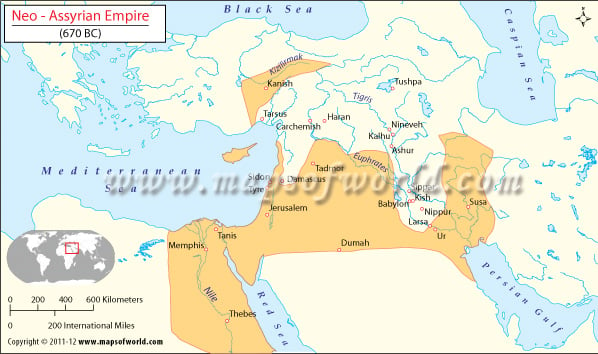The Neo-Assyrian Empire of Mesopotamia formed around 940 BC and ended around 600 BC. In a span of about 350 years the Assyrians made a bid for supremacy among the known civilizations of the world.
By the eighth century BC, Assyrian King Tiglath-Pileser III had built a vast empire spanning across Egypt, Anatolia, Africa, and Mesopotamia.
The Neo-Assyrian Kings
Two distinct dynasties are known to have ruled the Neo-Assyrian Empire. The early kings of the Neo-Assyrian Empire were direct descendents of the Assyrian monarchs of the Middle Kingdom. King Sargon II was followed by a line of illustrious kings. The last of the great kings of the Neo-Assyrian Empire was King Ashurbanipal who ascended the throne in 668 BC.
Scholars vary on the exact dates of reign of the Neo-Assyrian kings. The following is a widely acknowledged Neo-Assyrian kings list.
|
|
Neo-Assyrian Culture
The Neo-Assyrian kings were great patrons of art and literature. King Ashurbanipal’s collection of ancient Mesopotamian literature in Nineveh includes the best preserved versions of the Epic of Gilgamesh and Atra-Hasis. Cuneiform writing was still in vogue and though the elite scribes used Akkadian, Aramaic was the preferred language of the masses. The superior architecture of the Neo-Assyrians is evident in cities such as Damascus, Tyre, Sidon, Thebes, Hattusha, and Babylon.
Fall of the Assyrian Empire
The death of King Ashurbanipal in 631 BC heralded the disintegration of the Assyrian Empire. Babylon had been a weak link in the Neo-Assyrian Empire. While Ashurbanipal had successfully quelled Shamash-Shum-Ukin’s rebellion in Babylon, his son Ashur-Etil-Ilani was ousted by General Sin-Shumu-Lishir who was in turn replaced by Sin-Shar-Ishkun. Chaldean dominance in Babylon resulted in a rebellion of the vassal states that rallied under Nabopolassar. By 625 BC, most of Babylonia was embroiled in civil war.
Besides internal rivalry, Assyria also faced the combined offensive of Nabopolassar and the Median King Cyaxares. By 612 BC, Nineveh, the Assyrian capital, had fallen and King Sin-Shar-Ishkun had been killed. Greatly weakened, Assyria could offer token resistance with support from the Egyptians, and in 605 BC Assyria had ceased to exist as an independent nation. By about 800 BC, Aramaic had started to replace Akkadian as the local language of Assyria. By 605 BC very few people knew Akkadian.

